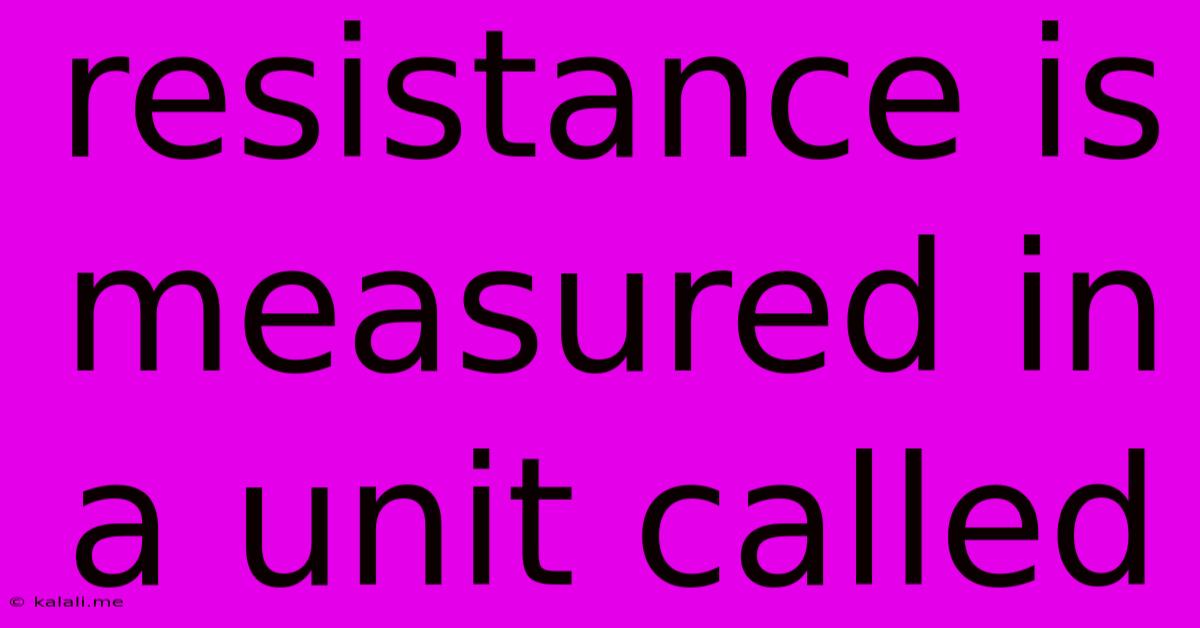Resistance Is Measured In A Unit Called
Kalali
Jun 14, 2025 · 3 min read

Table of Contents
Resistance: Measured in Ohms
Electrical resistance is a fundamental concept in physics and electrical engineering. Understanding resistance is crucial for designing and troubleshooting circuits, and knowing its unit of measurement is the first step. This article will explore what resistance is, why it's important, and definitively answer the question: resistance is measured in a unit called ohms.
Resistance is the opposition that a substance offers to the flow of electric current. Think of it like friction in a water pipe – the rougher the pipe's interior, the more resistance the water encounters. Similarly, in an electrical circuit, some materials impede the flow of electrons more than others. This impedance is quantified as electrical resistance.
Factors Affecting Resistance
Several factors influence the resistance of a material:
-
Material: Different materials possess different inherent resistance properties. Conductors like copper offer low resistance, while insulators like rubber offer high resistance. This property is quantified by resistivity, a material-specific constant.
-
Length: The longer the conductor, the greater the resistance. Imagine a longer water pipe – the water has to travel further, encountering more friction.
-
Cross-sectional Area: A thicker conductor (larger cross-sectional area) offers less resistance. A wider pipe allows for easier water flow, similarly, a larger area allows for easier electron flow.
-
Temperature: Temperature significantly impacts resistance. In most conductors, resistance increases with temperature. This is because increased temperature leads to greater atomic vibration, hindering electron movement.
The Ohm: Unit of Resistance
The unit of electrical resistance is the ohm, symbolized by the Greek letter Ω (omega). One ohm is defined as the resistance between two points of a conductor when a potential difference of one volt applied across these points produces a current of one ampere. This relationship is described by Ohm's Law: V = IR, where V is voltage, I is current, and R is resistance.
Importance of Understanding Resistance
Understanding resistance is crucial for several reasons:
-
Circuit Design: Engineers use resistors to control current flow in circuits. Resistors with specific ohm values are used to ensure components receive the correct amount of current.
-
Power Dissipation: When current flows through a resistor, energy is dissipated as heat. This is described by the equation P = I²R, where P is power. Understanding resistance is vital for preventing overheating and component failure.
-
Troubleshooting: Measuring resistance helps in identifying faulty components in a circuit. An abnormally high or low resistance can indicate a problem.
-
Safety: Resistance plays a crucial role in safety measures. Fuses and circuit breakers utilize resistance to protect circuits from excessive current.
Beyond Ohms: Other Related Concepts
While the ohm is the primary unit for resistance, related concepts utilize derived units. For example, conductance, the reciprocal of resistance, is measured in Siemens (S). Resistivity, a material property, is measured in ohm-meters (Ω·m).
In conclusion, the answer is clear: resistance is measured in ohms. Understanding this fundamental unit and the factors influencing resistance is essential for anyone working with electricity, from hobbyists to professional engineers. By grasping these concepts, you can effectively design, analyze, and troubleshoot electrical circuits safely and efficiently.
Latest Posts
Latest Posts
-
The Mass Per Unit Volume Of A Substance Is Called
Jun 15, 2025
-
What Is The Opposite Of Dangerous
Jun 15, 2025
-
Which Of The Following Is A Mechanical Wave
Jun 15, 2025
-
Is Dcm More Dense Than Water
Jun 15, 2025
-
Parts Of Four Stroke Petrol Engine
Jun 15, 2025
Related Post
Thank you for visiting our website which covers about Resistance Is Measured In A Unit Called . We hope the information provided has been useful to you. Feel free to contact us if you have any questions or need further assistance. See you next time and don't miss to bookmark.